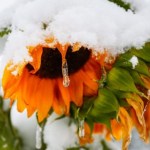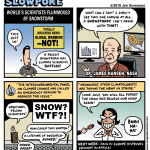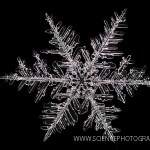Snow
The California drought continues.
While we do not know yet what the rest of the wet season will bring – and while we hope for the major storms needed to recharge our rivers, groundwater and reservoirs – it seems increasingly likely that California will not see enough precipitation to get out of the very deep deficit that three years of drought (so far) have produced.
There is, however, some misleading and confusing information out there. Some are already arguing that California’s rainfall is nearly back to normal or that because there may have been more serious droughts in the past we needn’t…
I grew up in Calgary and a small bedroom community west of it called Bragg Creek. This event is not on a par with the flooding of a couple years ago, but it still qualifies as "freaky".
Freak Summer Snowstorm in Calgary Leaves 30,000 Without Power.
Snow. Glaciers. Icecaps, River flows. All of these are vulnerable to climate change, especially rising temperature. This isn't just theory. It’s now observable fact.
Scientists worry about the growing threat of climate change because the global climate is tied to everything that society cares about: human and environmental health, food and industrial production, water availability, extreme events, and more. Figuring out how all these pieces tie together is difficult. And many of us, from scientists to the public to policy makers, have only a partial understanding of the true…
One of the reasons that climate change is such a big issue is because the global climate is an integral part of the Earth’s entire ecosystem, tied to so many of the big and little things that society cares about. Figuring out how all these complicated pieces tie together is hard, as is linking these pieces together in the minds of the public so that we – and our policy makers – can grasp the true implications of a changing climate and plan for them. Because this is so important, I expect that many of my future posts here will address this issue, but let me start with one example: the…
Exciting news just in - its cold in Cambridgeshire. All over the UK I expect, but I haven't checked. indeed I haven't checked out all of Cambridgeshire, let alone Cambridge, but never mind I'll trust the reports. I tried putting my foot onto the snow and I can confirm: yes, it is cold. Not much snow mind: maybe 1 cm when fresh.
Cycling is fun too. I haven't come off, but then again it is dry-cold mostly in the evening coming back, and in the morning the streets at least are ice-free. Rowing this evening was distinctly chilly. Don't click on the photo to the left - its rubbish. See the Fort…
As fate would have it, no sooner does a disengenous commenter here point out the unusual cold and snow falling on my hometown of Vancouver, Canada than I come accross this amusing comic from Jen Sorenson:
On Saturday evening as my family went out to synagogue for purim, I was astonished - driving through Schenectady there were only a few inches of snow on the ground. Now we often get more snow than lower elevations, but this time the difference was astounding - we have nearly four feet of snow on the ground.
I like snow, but I admit, I've never dealt with this much, accumulated so quickly - it snowed non-stop from Tuesday morning until Saturday night. Sometimes we had gentle flakes, other white-out, but snow it did, and looking out this sunny morning, my four and a half foot goat fences are…
Three feet and counting so far. The prediction for the "upper elevations" (that would be us) is that we could get another 1-2 feet before tomorrow night. So while I am lost in meditation of the stunning beauty that surrounds me and trying to locate my woodpile, our car and the dog, all of whom are largely encompassed and hidden by snow, I leave you with some alternate reading.
First of all, in the "deeply sorrowful things" category, Leila, who posted at ye olde blogge as "Bedouina" and "Leila" died this fall. I hadn't realized it - and I feel terrible that I did not realize. The last…
Yet more snow. This lot only just settled; moderately thick, but turned to slush later in the day. In particular, the puddle of dirty roadside slush I feel into was cold and wet. But along the footpath it was still beautiful:
This is to prove to Jules that the UK isn't all bad.
CSR is less enchanting, but even so the symmetry is appealing.
As to ENSO... hmm. Don't get your hopes up.
A lot of big snowstorms get people who do not grasp the difference between weather and climate all excited. Consider the VA Republican party who claimed in an ad last week that if it snows, we can't have global warming. But it isn't just the skeptics and denialists here - among the believers we routinely see people citing weather, such as the lack of snow in Vancouver for the Olympics. I know that people think this helps, but in the great scheme of things, it doesn't - if people hear people who are trying act against global warming using their weather as an explanation without evidence,…
So for those of you getting ready for Snowpocalypse, as the mid-Atlantic faces, gasp - a whole foot of snow, I have to tell you something. I'm jealous. I mean really, really jealous. I want your snow.
A general pattern of winter storms in my area (upstate NY) is that they come down from Canada and across the Great Lakes. We are at the very eastern edge of the snow belt in New York, and we don't usually get the giant lake-effect snows that Buffalo and other areas get, but we can generally expect to spend the winter with a solid several feet on the ground. But not this year.
Somehow, all…
Cold, isn't it? And quite dark too (is that the [[Equation of time]]?).
But I'm rather enjoying this snow - it is clear and crisp, so far. I've only fallen off once.
[Update: Looks cold but lovely from above [http://news.bbc.co.uk/1/hi/in_depth/8447023.stm
]. Mind you, it is warm elsewhere]
There are sandals underneath that, in case you'd missed how hard I am :-)
My journey to the world of snowflakes started about 15 years ago and began with my love for microscopes. Upon showing images from the microscope to friends they had little interest in all the wonderful biology, but were fascinated by the images of snowflakes. There had been little done in this field since Bentley fist took snowflake images from his barn in the hills of Vermont approximately 100 years ago.
I live and work in one of the snowiest cities in the United States. Rochester N.Y. is situated between Buffalo and Syracuse and it is often a coin toss which city gets the most snow.…
Picture it. A bridge in Connecticut, January 2004. Having left New York at 4:30 am, I settled into my Honda hoping to reach Maine before nightfall. The first couple hours were uneventful until... suddenly the wheel locked, the brakes failed and my car spun haphazardly across three lanes to face oncoming traffic. Yet somehow, we didn't suffer a scratch between us.
I was lucky, and I want to encourage readers in the northeast to keep black ice in mind as you brave the roads this morning. And since this is scienceblogs, what causes the slippery stuff anyway?
Black ice is ice that forms…
I was going to go to school and give a final. I guess that is not going to happen now. My daughter measured 7 inches of snow - in Hammond, Louisiana (50 miles from New Orleans). Here are some pictures - more to come (plus video).
From Winter Storm 2008
From Winter Storm 2008
From Winter Storm 2008
tags: Etu-Töölö, Helsinki, Finland, nature, image of the day
Walking through Helsinki after the snowstorm.
Etu-Töölö, Helsinki, Finland, 24 November 2008.
Image: GrrlScientist, 24 November 2008 [larger view].
tags: Etu-Töölö, Helsinki, Finland, nature, image of the day
Walking through Helsinki after the snowstorm.
Etu-Töölö, Helsinki, Finland, 24 November 2008.
Image: GrrlScientist, 24 November 2008 [larger view].
tags: Hietakannas, Helsinki, Finland, nature, image of the day
Walking through Helsinki after the snowstorm.
Hietakannas, Helsinki, Finland, 24 November 2008.
Image: GrrlScientist, 24 November 2008 [larger view].
Read and learn more about Hietakannas.
tags: Etu-Töölö, Helsinki, Finland, nature, image of the day
Walking through Helsinki after the snowstorm.
Etu-Töölö, Helsinki, Finland, 24 November 2008.
Image: GrrlScientist, 24 November 2008 [larger view].
The next time you watch a snowfall, just think that among the falling flakes are some that house bacteria at their core.
It's a well known fact that water freezes at 0°C, but it only does so without assistance at -40°C or colder. At higher temperatures, it needs help and relies on microscopic particles to provide a core around which water molecules can clump and crystallise. These particles act as seeds for condensation and they are rather dramatically known as "ice nucleators".
Dust and soot are reasonable ice nucleators but they are completely surpassed by bacteria, which can…


